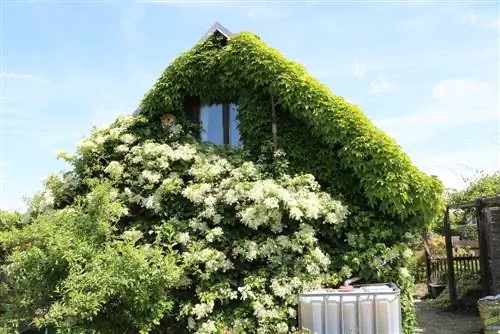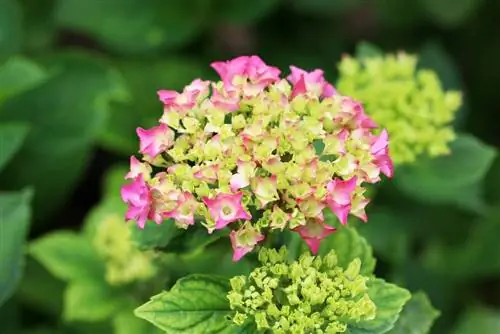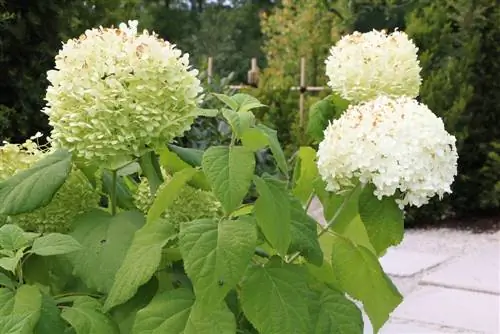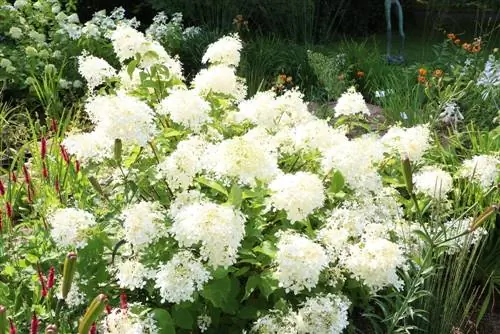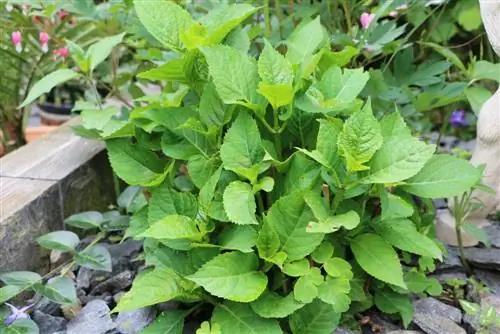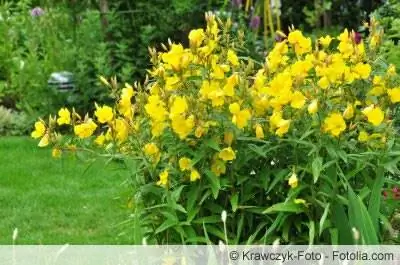- Author admin [email protected].
- Public 2023-12-17 03:39.
- Last modified 2025-01-24 12:45.
The decorative and easy-care climbing hydrangea takes a few years until it develops its huge white and fragrant flowers for the first time in the early summer months. In the meantime, their shoots climb up to fifteen meters in height thanks to their adhesive roots on walls or suitable climbing aids. In summer it impresses with shiny green foliage and in autumn with bright yellow leaves.
Location and soil
The climbing hydrangea prefers a wind-protected place with a trellis in partial shade to shade. However, it also thrives in sunny locations if there is enough water. The soil should be well-drained and humus-rich. If its pH value is in the acidic to neutral range, this is an ideal living condition for the climbing plant. Hydrangea petiolaris does not tolerate calcareous soil, nor does waterlogging. Climbing hydrangeas can also be cultivated in large planters. Here you also need an appropriate climbing aid.
Hydrangea petiolaris loves to climb and climbs everywhere. Regardless of whether they are smooth walls, downpipes, fences or tree trunks, their roots find a gap to hold on to everywhere. In the worst case scenario, this can cause damage, for example to the masonry. It is therefore better to give the hydrangea a climbing aid when planting. Various materials can be used for this:
- open constructions made of wooden slats
- Metal grille
- Cable systems that are drilled into a wall, for example
- Nets
- Wire Meshes
- Rose Arches
- Pergolas
Since the hydrangea develops a considerable weight over the years, it is important to ensure that it is as stable and stable as possible when selecting the climbing aid.
Planting and care
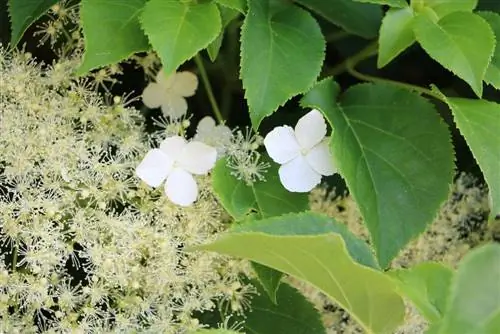
Similar to rhododendrons, climbing hydrangeas require slightly acidic soil to thrive. With the help of a soil test, the pH value of the future location can be checked before planting. If the pH value is above 7, composted leaves, peat or rhododendron soil are incorporated to lower it. The best time to plant a climbing hydrangea is in May after the Ice Saints, when ground frosts are no longer expected.
Planting climbing hydrangea correctly
- Dig up the soil and rake it well, the soil must be loose and crumbly
- Incorporate compost for optimal nutrient supply
- Dig out a planting hole, if possible twice as big as the root ball
- To protect against waterlogging, create a drainage layer with potsherds or gravel in the planting hole
- Soak the root ball in a bucket with water
- put some substrate on the drainage layer
- Place climbing hydrangea in the middle
- Fill the hole with substrate
- as a final top layer, apply organic mulch (retains water) and press down lightly
- Create a watering edge so that the water does not spread into the surrounding area
- Water the plant
Now all that's missing is a suitable climbing aid for the new plant. The lower shoots of the hydrangea are attached to this for better support. As soon as the shoots grow, they form adhesive roots that attach themselves to the trellis, the fence or the wall. If necessary, long shoots on fences can also be loosely secured with small wire rings to guide them in the desired direction.
Hydrangea petiolaris always needs enough water, the soil should always be kept moist, but waterlogging should be avoided. If the plant is too wet, the white panicles may wilt in the middle of the flowering period. Too little water or too much sun also causes the flowers to wilt.
pot planting
Buckets with decorative flowers or small shrubs often find a suitable place on the balcony or terrace.
They serve as privacy screens and bring nature very close to the coffee table. In order for a hydrangea to thrive in a planter, there are a few rules to follow:
- there must be an opening in the bottom of the planter
- Introduction of a drainage layer at the bottom of the pot
- spread a layer of substrate over it
- Mix substrate from flower and rhododendron soil
- Dig Hydrangea petiolaris in the middle
- Fill the pot with substrate and press the soil lightly
- Water the plant
- Attach trellis and tie shoots loosely
Watering and fertilizing
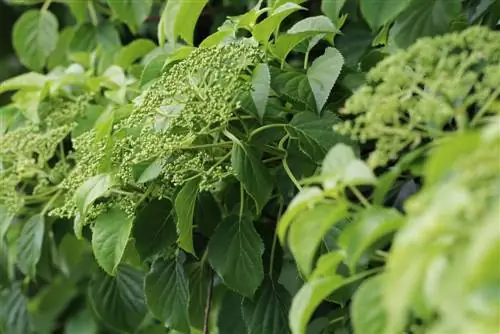
Climbing hydrangeas always need enough water and nutrients. Regular watering, even daily in summer, is required. After just one day of high temperatures, the leaves and flowers of the hydrangea hang limply. It is therefore advisable to water the plant early in the morning and late in the evening in summer. The irrigation water should contain as little lime as possible, as the hydrangea is sensitive to this mineral. Watering is carried out at the base of the plant trunk, exactly above the root area. A pouring rim prevents the water from accidentally running off.
Tip:
Collect rainwater in decorative barrels. This means that low-lime irrigation water is always available.
From May, fertilization is carried out every 14 days until August. From September onwards, the hydrangea no longer needs fertilizer. It is best to use hydrangea, azalea or rhododendron fertilizer. Alternatively, compost or horn shavings/horn meal can also be incorporated into the soil. Artificial fertilizer such as blue grain is not recommended for Hydrangea petiolaris. Blue grain contains too much phosphorus. If the hydrangea grows in a planter, fertilizing with conventional liquid fertilizer is sufficient.
Cutting
Climbing hydrangeas tolerate pruning, but do not normally require pruning. If a cut still needs to be made, the best time for this is February and March. The shoots of young specimens are shortened by around a third immediately after planting. The cut encourages the plant to branch out more. If there is a lack of space or unsightly growth, older plants can be cut back to the old wood. However, when cutting, you have to remember that the hydrangea lays the foundations for next year's inflorescences in autumn. If you cut off too much, there may be no flowers next year.
Rules for a good cut
- remove dead and frozen shoots in spring
- Cut dead wood at the base
- remove unwanted shoots that have grown too long immediately after flowering
- Separate shoots over a bud
- Use sharp and clean scissors so that the branches are not bruised and the wounds heal cleanly
Tip:
If the climbing hydrangea is used as a ground cover, regular pruning is necessary to prevent it from spreading in unwanted places.
Transposing and repotting
Hydrangea petiolaris loves its location, moving or repotting should only be done in exceptional cases. If it still needs to be implemented, spring or autumn is the best time to do it. Before digging up the plant, its shoots should be cut back to 50 cm. The climbing hydrangea is then plucked out over a large area in order to injure as few roots as possible. Before the hydrangea is planted in its new location, the planting hole must be well watered. The plant will root more quickly if loose, humus-rich soil is used to fill the planting hole.
Once the planting hole has been filled, never touch the soil! The pressure would damage the sensitive roots. Regular watering is necessary in the following weeks because the plant needs to take root in its new location. After the transplant, the climbing hydrangea will probably not bloom for a few years. It needs time to recover and develop new roots.
Wintering
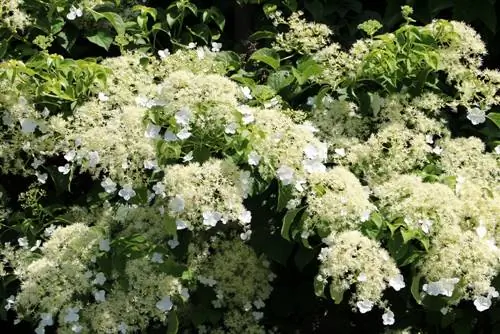
The Hydrangea petiolaris is a hardy climbing plant that can survive even severe frost. However, young and potted plants need winter protection. Young plants growing in a bed are given a layer of leaves or straw to protect them from the cold. If climbing shoots have already formed, they are covered with raffia mats. The container is wrapped in foil to protect the sensitive roots. From the age of two, the climbing hydrangea no longer needs winter protection.
Propagation
Climbing hydrangeas can be easily propagated with little effort. The best time for this is the months of July and August. Planters or cuttings are suitable for propagation. For lowering, you use side shoots close to the ground that are lowered into the ground.
Propagation step by step
- select a suitable, non-woody shoot
- Remove leaves, make a wound cut in the center piece (remove a narrow piece of bark on the underside of the shoot)
- Place the shoot at the interface in humus-rich soil and fix it, the shoot tip still protrudes about 10 cm from the ground
- water well
Tip:
Do not separate the sinker from the mother plant until it is well rooted and has formed new shoots.
This year's side shoots that are already woody, have not yet bloomed and have no buds are suitable for head cuttings.
Propagation step by step
- Select side shoots 10 to 15 cm long
- Cut diagonally below one eye (water can be absorbed better this way)
- remove lower leaves
- Dip the cutting surface into rooting powder (this is not necessary, but it stimulates root formation)
- Plant the cutting in a pot with a sand-peat mixture
- place in a bright, sheltered place, no direct sun
- pour and always keep moist
Fresh cuttings are very sensitive to cold and must therefore be overwintered in a bright, frost-free place. The following spring, after the Ice Saints in May, the young climbing hydrangeas can be planted in their future regular location.
Diseases and pests
The robust climbing hydrangea is rarely attacked by diseases or pests. The occurrence of chlorosis can rarely be observed. With this disease, the leaves turn yellow, but have green veins running through them. Occasional doses of rhododendron soil or peat prevent the occurrence of chlorosis.
In the summer months, powdery mildew and downy mildew can also appear on the shoots and flowers of the hydrangea. Powdery mildew is a fungal disease that causes a whitish, mealy coating. Powdery mildew mainly attacks the leaves. The white coating can be easily wiped off. An infected leaf turns brown and eventually falls off. Downy mildew can be observed with a white coating on the underside of the leaves. Here the fungus penetrates deep into the plant.
Fungicides that are sprayed onto the affected plant are suitable for combating it. If you want to avoid chemicals, spray with garlic or horsetail decoction.
Tip:
Use ladybugs as a natural mildew control agent. Sixteen- and twenty-two-spot ladybugs feed exclusively on this fungus.
Aphids on hydrangea cause buds to fall off and leaves to curl. The sucking insects can be combated with a strong and targeted jet of water, with nettle broth or with soapy water. These measures are environmentally friendly, but must be repeated frequently. Chemical sprays bring more lasting success, but are toxic to bees and other beneficial insects. If you want to fight aphids naturally, use larvae of ladybirds and lacewings.
Types of climbing hydrangea
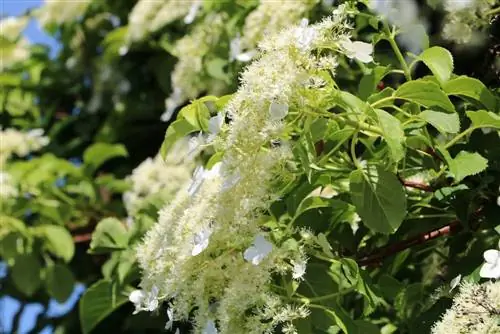
Through many years of breeding, various varieties of Hydrangea petiolaris are available. Miranda and Cordifolia delight with creamy white flowers, Semiola and Silver Lining shine in pure white. The Hydrangea seemannii is a very special climbing hydrangea. It is an evergreen species with white flower umbels that is native to the Mexican mountains. It takes a few years for it to bloom for the first time. The sun-drenched Mexican needs a protective fleece in winter, otherwise its leaves would freeze.
A close relative of the climbing rose Hydrangea petiolaris is the hydrangea or split hydrangea. They differ mainly in the shape of the flowers. The creamy white flowers consist of a crown of a few sterile, heart-shaped petals and a flat center of many fertile flowers. The mock hydrangea also loves semi-shady to shady locations and requires little care.

